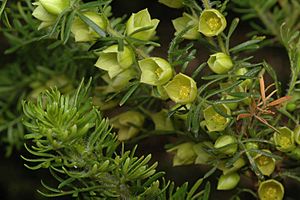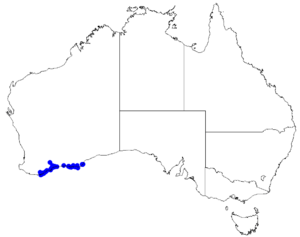Yellow boronia facts for kids
Quick facts for kids Yellow boronia |
|
|---|---|
 |
|
| Boronia tetrandra in the Australian National Botanic Gardens | |
| Scientific classification | |
 |
|
| Occurrence data from Australasian Virtual Herbarium | |
| Synonyms | |
|
Yellow boronia (scientific name: Boronia tetrandra) is a cool plant from the citrus family, called Rutaceae. It only grows naturally in Western Australia, which means it's endemic there. This plant is a shrub that can spread out or grow straight up. It has fuzzy stems, leaves with many small leaflets, and pretty cup-shaped flowers. These flowers can be greenish-cream, yellow, or even reddish-brown, and they always have four petals.
Contents
What Does Yellow Boronia Look Like?
Yellow boronia is a shrub that can grow from about 10 centimeters (4 inches) to 1 meter (3 feet) tall, or even taller! Its branches are covered with long, soft hairs.
Leaves and Flowers
The leaves of the yellow boronia are special. They are pinnate, which means they have many small leaflets arranged along a central stem, like a feather. Each leaf can have anywhere from five to thirteen or more tiny leaflets, each about 12 millimeters (half an inch) long.
The flowers are cup-shaped and can be greenish-cream, yellow, or reddish-brown. You'll find them growing by themselves where the leaves meet the stem. Each flower has four broad, hairy sepals (which protect the bud) and four petals. These petals are about 7.5 to 10 millimeters (0.3 to 0.4 inches) long and overlap each other.
Inside the flower, there are eight stamens, which are the parts that make pollen. They are different lengths. The ones closer to the sepals are thick with large pollen-making parts called anthers. The ones closer to the petals curve towards the style (the central part of the flower) and have tiny anthers. The very top part of the style, called the stigma, has four lobes. Yellow boronia usually blooms from May to October.
How Yellow Boronia Got Its Name
The scientific name for yellow boronia, Boronia tetrandra, was first officially written down in 1805. This was done by a scientist named Jacques Labillardière in his book Novae Hollandiae Plantarum Specimen.
The second part of its name, tetrandra, comes from two Ancient Greek words. Tetra means "four," and aner means "male." This name likely refers to the four main stamens (the "male" parts) in the flower.
Where Does Yellow Boronia Grow?
You can find yellow boronia growing in specific areas of Western Australia. It likes to live on rocky granite outcrops, sandy coastal dunes, and limestone cliffs. These areas are part of what scientists call the Esperance Plains and Jarrah Forest biogeographic regions.
Is Yellow Boronia Protected?
Good news! The Western Australian Government's Department of Parks and Wildlife says that yellow boronia is "not threatened." This means there are plenty of these plants around, and they are not currently in danger of disappearing.

